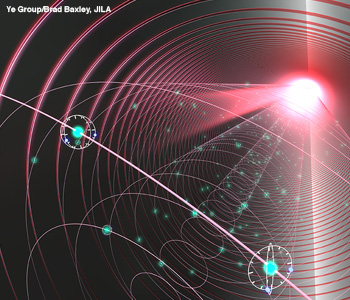
An atomic view from the inside of the optical lattice.
Researchers in the United States have built a new optical lattice clock that measures seconds far more precisely than the world's standard definition of a second.
OSA Fellow Jun Ye and his group at the U.S. National Institute of Standards and Technology and JILA (Boulder, Colo.) have built a stable clock based on several thousand neutral strontium atoms (Nature, doi:10.1038/nature12941). With an accuracy of 6.8 x 10–18, the new clock beats the most accurate single-ion timepiece. In fact, it's so accurate that it took the scientists a year to analyze all the potential sources of error in the system.
Within the new clock, the strontium atoms, supercooled to about 3 µK, are held within a one-dimensional lattice by beams from lasers operating near the so-called “magic wavelength” of 813 nm, where two electronic states of an atom experience the same trapping potential. According to Ye, neutral atoms do not electrostatically repel each other, so they are easier to load into the lattice than ions.
The extreme stability of the strontium lattice clock—in the 10–18 range—gave the JILA group plenty of time to quantify all the uncertainties in the experiment, from blackbody radiation in the device's environment to the lattice Stark effect, first- and second-order Zeeman shifts, background gas collisions and the phase chirp from the acousto-optic modulators controlling the lasers. “You really have to give them the best possible laser coherence time,” Ye says of the lattice. “You have to have patience to let these atoms tick.”
Could the new advances in optical lattice clocks lead to a more precise definition of the second, which was set in 1967 based on the transition between two hyperfine levels in the cesium-133 atom? That might take years of study among the world's metrologists, according to Ye. The newer clocks will continue to push the limits of measurement science and quantum physics. Meanwhile, cesium atomic clocks are still plenty accurate enough for navigation and the Global Positioning System.
